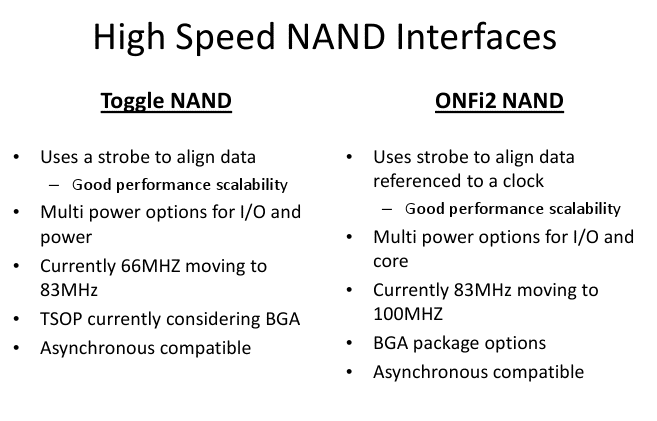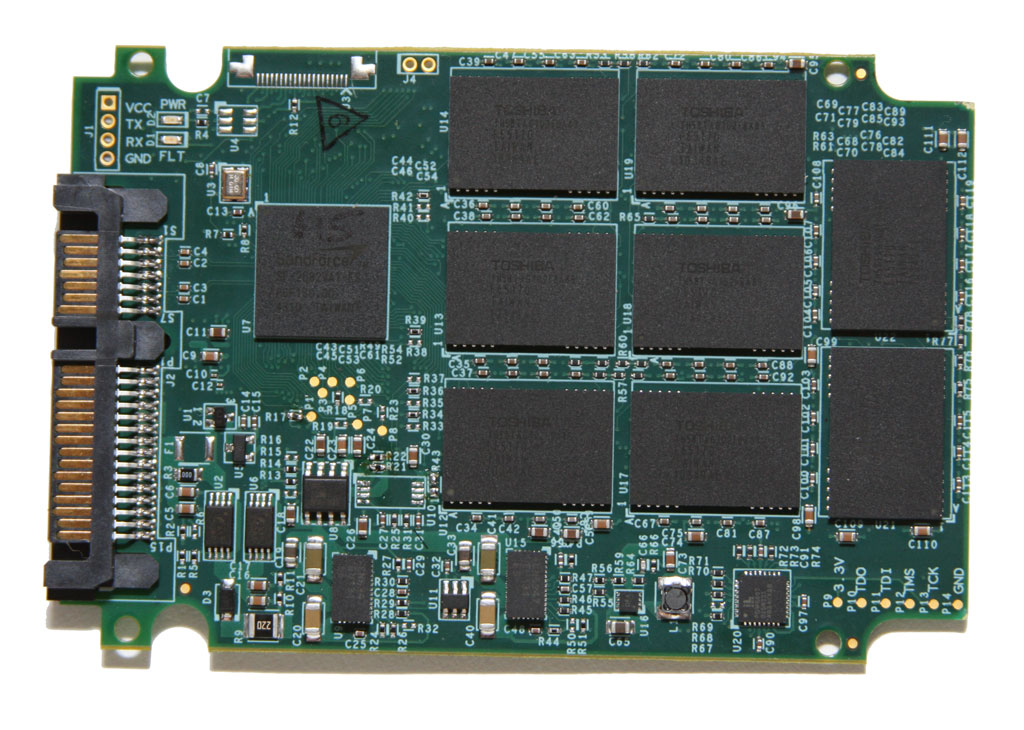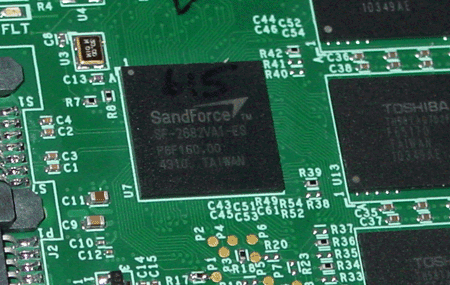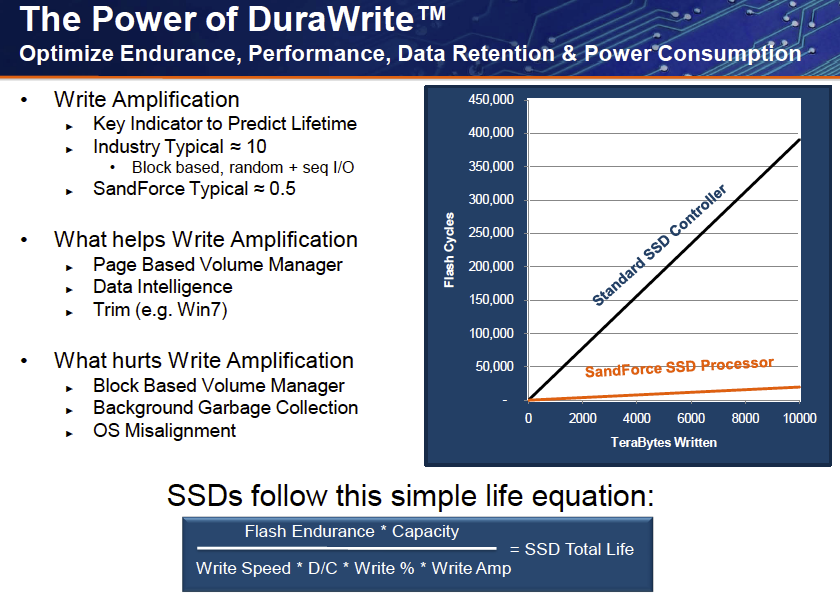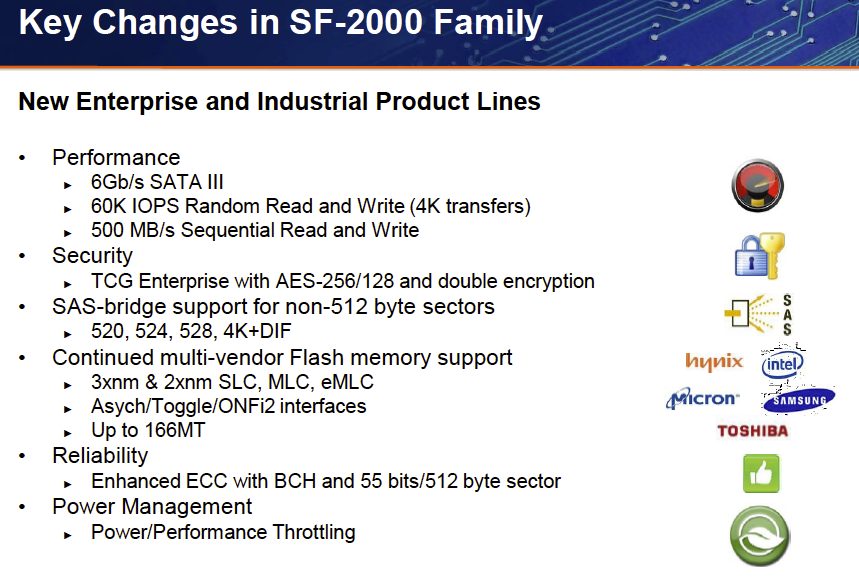OCZ's Vertex 3 Pro: Second-Gen SandForce Perf Preview
More Specs And SandForce's Second-Gen Controller
Having explained the differences between MLC and SLC, it might surprise you to learn that the Vertex 3 Pro is still using MLC memory. Remember, though, that one of SandForce's pioneering breakthroughs was a minimization of write amplification through several techniques inherent to its controller. This purportedly allowed SSD builders to utilize lower-quality NAND (yes, there are multiple "grades" of flash) without compromising the drive's lifespan. Besides the controller, little has changed from the Vertex 2 Pro to the Vertex 3 Pro. SandForce/OCZ are using a formula that they think works: MLC NAND and 28% overprovisioning.
We’ll get to SandForce's contribution to the Vertex 3 Pro shortly. Before diving too deeply into our performance preview, though, again, understand that this is a pre-production piece of hardware. More so than some of the other early devices we test, technical details could possibly change. As it stands, our sample features Toshiba’s 32 nm 4 GB (32 Gb, 2-bits per cell) toggle-mode MLC NAND (first seen in Roundup: The Best SSDs For Enthusiasts) in an eight-channel configuration.
OCZ tells us that it's also considering Intel’s 25 nm 8 GB (64 Gb, 2-bits per-cell) ONFi-based MLC NAND. Besides the different wafer size, you might wonder about the two different NAND technologies that SandForce is supporting with its new controller. The difference between them is in the interface of the package. This is still DDR technology, so both are limited to two transactions per clock. The only difference is where those transactions occur. ONFi uses a clock to sync the read and write command within a given cycle, similar to a CPU cycle, but this requires additional power.
Now, you might think that a free-running clock means ONFi NAND requires more power. At the implementation level, that isn't necessarily the case. Flash memory requires so little power compared to other components in an SSD that the power debate is largely irrelevant from that angle. This means that OCZ's final choice on what to use with the Vertex 3 Pro is really going to come down to availability and price. Think of this as another format war. Intel, Micron, and Hynix are on the ONFi side, while Samsung and Toshiba are on toggle-mode's.
The 200 GB drive that OCZ sent to our SoCal lab turns out to be 186 GB in Windows. Each of the 16 NAND devices has four 4 GB MLC dies, which comes out to a total of 256 GB. This means that 70 GB is reserved for data parity, garbage collection, and block replacement. In the 200 GB drive, 4 GB is used specifically for RAISE, but we'll cover that separately.
OCZ is currently planning to offer the Vertex 3 Pro at three different capacity points: 100 ($525), 200 ($775), and 400 GB ($1350). Performance is expected to be relatively similar from one to the other (the 100 GB model might take a small hit if OCZ goes with the 25 nm NAND), and we shouldn't see a significant deviation in performance from the numbers we'll be presenting today.
| Header Cell - Column 0 | MSRP | Price/GB |
|---|---|---|
| Vertex 3 Pro 100 GB | $525 | $5.25/GB |
| Vertex 3 Pro 200 GB | $775 | $3.88/GB |
| Vertex 3 Pro 400 GB | $1350 | $3.38/GB |
When you look at these prices, remember we're talking about a device that OCZ considers enterprise-grade. That is to say it includes features and functionality that you wouldn't find in a consumer-level SSD. Most notable is the supercapacitor so prominently featured in the image above. In the event of a power loss, that component allows the drive to make sure buffered data is written to the flash, preventing data loss. This isn't a new feature--OCZ first employed it on the Vertex 2 Pro. But it's one of the reasons you pay so much for a Pro drive versus one of the consumer-grade models.
Get Tom's Hardware's best news and in-depth reviews, straight to your inbox.
SF-2500: SandForce's Second-Gen Controller
The magic in OCZ's newest drive happens at the controller level. Indeed, this is the first drive we've tested based on SandForce's SF-2000 family. As you can see from the shot above, we have SF-2682 silicon because that's what was built for the first batch of controllers. OCZ is leveraging the firmware from the SF-2582, though, and that's the silicon/software you'll find once Vertex 3 Pro drives start shipping.
In order to understand what SandForce has changed, you need to understand how a SSD writes data. Writing to NAND happens at the page level, and a page can be anywhere from 2 KB to 16 KB. Erasing data is different, though. This operation only can occur at the block level, which consists of hundreds of pages. If NAND can only be erased a fixed number of times, this creates an obvious conundrum.
The solution is to keep from erasing old data until it's absolutely necessary to make room for new data. Since each cell is limited by the number of erases, you want to evenly spread those erase operations out by preemptively writing evenly across the drive. It's the controller's job to address this, and it's part of what sets controller hardware apart. Typically, controllers do this by having huge tables that map and track where all the data is being written. Good controllers know when to group small random writes together in such a way as to generate a larger sequential write. Everything you do to ensure even wear has a tendency to penalize performance, as tracking requires a lot of processing and memory overhead, which is why Crucial's C300 has a massive 256 MB DRAM.
SandForce approaches this problem differently. It tossed out the traditional method of actively sending the data to NAND. Instead, its controller operates more like a switch that monitors active channels to minimize NAND request handling. It can get away with this because the SandForce controller attempts to reduce the size of what is being written.
Compression is what sets SandForce apart from the rest. The fine print, which we see represented in the benchmarks, is that random or already-compressed data doesn't benefit. By not having to write as much as other controllers, SandForce gets away with having a smaller buffer. The buffer size is larger in its second-gen design, but the increase has more to do with 6 Gb/s signaling (still under 512 KB, according to the company).
There are five major changes that come with SandForce's newest controller, though not all of them are seen on the Vertex 3 Pro.
- Better Performance. Of course, we have native 6 Gb/s support for both SAS and SATA. In fact, the SF-2682 is the first SAS-specific SSD controller we have seen. Last year, in its first presentation of the SF-2000 family, SandForce claimed its newest controllers would achieve 500 MB/s sequential reads and writes, with 4 KB random read/write IOPS of up to 60 000. The fact that OCZ says its Vertex 3 Pro achieves higher sequential performance and even better I/O throughput gives us a definite target to look for in the benchmarks.
- With updated support of Toggle and ONFi 2.2, SandForce maintains support for flash from multiple suppliers. As a controller vendor, it's in SandForce's best interest to maintain broad compatibility. The SF-2000 family works with 3x and 2x nm NAND devices based on SLC, MLC, and eMLC memory. It doesn't matter if the vendor employs asynchronous, ONFi, or toggle-mode memory, which of course leaves the door wide open for OCZ to pick and choose from the flash available today.
- Security gets a notable boost from AES-256 (up from 128-bit encryption previously), making it TCG Enterprise security subsystem class, defined by the Trusted Computing Group back in 2009. This isn't a big deal on the desktop, of course, but any time you're dealing with sensitive information in the business space, security is much more prevalent of a concern.
- Better Error Correction Code, covered on the next page.
- Power management. This applies more to mass scale deployment of drives where the power of numerous SSD in aggregate actually matters. SandForce is trying to get great IOPS/watt across the board. By limiting power consumption to a set level, SandForce's second-gen controllers achieve the maximum performance within that limit. This seems like a useful feature that may trickle down to the commercial version of the controller.
Because the SF-2000 family employs largely-similar internals as its predecessor, it's little surprise that the same SandForce-specific technologies drive SSDs based on these new controllers. Marketing-heavy terms like DuraClass and RAISE are every bit as important here. And, at the end of the day, these are key to SandForce's efforts to minimize write amplification factors and enhance data security.
Current page: More Specs And SandForce's Second-Gen Controller
Prev Page Meet OCZ's Vertex 3 Pro Next Page BCH ECC, Overprovisioning, And Moving To 6 Gb/s-
Bigmac80 This is why i haven't bought a SSD yet. One it's freakin expensive 2 not enough capacity 3 it's freakin expensive! It'll go down next year when the world ends in 2012.Reply -
falchard Price is lower then last generation. A shrink in die size means cheaper manufacturing costs, lower power usage, and better performance. Thats what happens when every hardware company shrinks their chips.Reply
Considering this is going to have the same amount of space, its going to be a cheaper SSD. -
aaron88_7 These are for enterprise use, that's why they are priced so high. They have features average consumers don't need. In other words, you're wasting your money if you are putting these into your home computer.Reply -
dragonsqrrl OCZ Vertex 3 Pro MSRP Pricing:Reply
100GB: $525, $5.35 per GB
200GB: $775, $3.88 per GB
400GB: $1350, $3.38 per GB
Getting cheaper, but still far outside my price range given their relative capacities. Even taking their amazing performance into account, it's still going to be a difficult sell for all but the most passionate enthusiasts, pros with heavy server workloads, or hardcore idiots. You're definitely not going to be getting your moneys worth putting one of these into your gaming rig. Enterprise type applications experience the largest benefits from these types of drives, and it's probably the only application where the performance benefits balance out the higher costs. -
JohnnyLucky The article made it perfectly clear the drive is not a drive that will be offered to consumers, gamers, and pc enthusiasts. How is OCZ going to reduce prices for consumer drives? Reduce features? Cut corners? Replace high quality components with lesser quality components? On answer is OCZ will reduc features. I'd like to know what else OCZ is going to do.Reply -
Please add a TrueCrypt benchmark to your SSD evaluations, for two reasons. First, the difficulty of truly erasing data on a flash drive makes data security more important. Second, there are drives (like Sandforce) that use compression and may behave differently when storing encrypted (high entropy) data.Reply
-
Miharu Presently Plextor M2-M2S offer 370-420MB/s read for what... (64gb)150$-(128gb)250$. Vextor 3 price is out of the loop, it's too expensive. At this price I can buy 2 Plextor and put them in RAID 0.Reply
